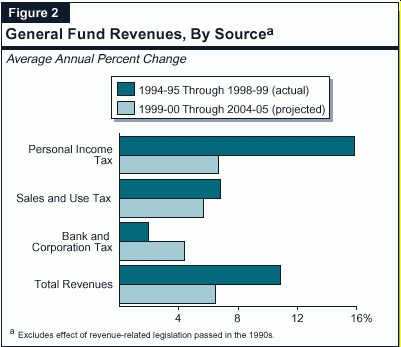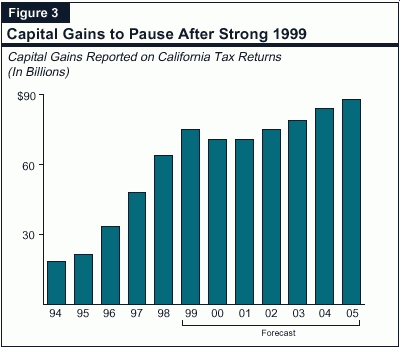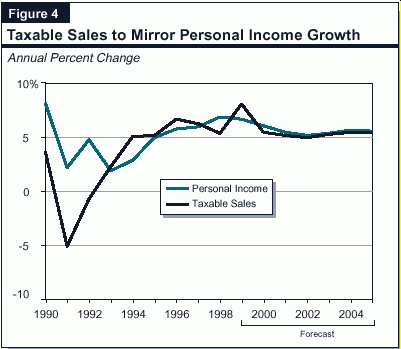
 |
California's Fiscal OutlookLAO Projections 1999-00 to 2001-02Part III |
The state's revenue outlook has improved substantially over the past several months, due to the combination of (1) higher 1998-99 year-end accruals, (2) a stronger near-term California economic outlook, and (3) higher current cash-receipt trends. Our revenue forecast is discussed below and summarized in Figure 1.
| Figure 1 | |||||||
| The LAO's Economic Forecast
1999 Through 2005 | |||||||
| Percent Change (Unless Otherwise Indicated) | |||||||
| 1999 | 2000 | 2001 | 2002 | 2003 | 2004 | 2005 | |
| United States | |||||||
| Real gross domestic producta | 3.9% | 2.8% | 2.6% | 2.2% | 2.6% | 2.4% | 2.6% |
| Wage and salary jobs | 2.2 | 2.7 | 1.1 | 1.1 | 1.2 | 1.2 | 1.1 |
| Consumer Price Index (CPI) | 2.4 | 2.8 | 2.0 | 2.4 | 2.5 | 2.5 | 2.6 |
| Unemployment rate (%) | 4.2 | 4.2 | 4.3 | 4.6 | 4.7 | 4.9 | 5.1 |
| Housing starts (000) | 1,675 | 1,568 | 1,545 | 1,499 | 1,504 | 1,515 | 1,510 |
| California | |||||||
| Personal income | 6.7% | 6.1% | 5.5% | 5.2% | 5.4% | 5.7% | 5.6% |
| Wage and salary jobs | 3.5 | 3.1 | 2.5 | 2.2 | 2.3 | 2.4 | 2.4 |
| Taxable sales | 8.1 | 5.5 | 5.2 | 5.0 | 5.3 | 5.5 | 5.5 |
| Consumer Price Index (CCPI) | 2.9 | 3.1 | 2.5 | 2.7 | 2.8 | 2.8 | 2.9 |
| Unemployment rate (%) | 5.3 | 4.7 | 4.8 | 5.1 | 5.2 | 5.2 | 5.3 |
| New housing permits (000) | 139 | 153 | 165 | 170 | 175 | 180 | 190 |
| a Data do not reflect late-1999 revisions to the National Income and Product Accounts | |||||||
Prior-Year (1998-99) Revenues. In the prior year, revenues are estimated to be $58.6 billion, which is $687 million more than assumed in the 1999-00 Budget Act. The higher total is primarily related to lower-than-expected personal income tax (PIT) refunds and higher-than-expected sales and withholding tax receipts during the first three months of this fiscal year--which were attributable to tax liabilities occurring in 1998-99 and, thus, were accrued back to the prior year.
Current-Year (1999-00) Revenues. We forecast that General Fund revenues will reach $64.8 billion in the current year, a 10.6 percent increase from 1998-99. Relative to the budget estimate, our projections for the current year are up by nearly $1.9 billion, reflecting both stronger near-term economic growth and recent positive trends in receipts from sales and personal income taxes.
Budget-Year (2000-01) Revenues and Beyond. In the budget year, we estimate that total General Fund receipts will reach $67.9 billion, a 4.7 percent increase from the estimated current-year total. Adjusting for receipts from asset sales and other one-time sources in the current year, revenues from ongoing sources are projected to increase by about 5.5 percent, or slightly less than our projected increase in statewide personal income for that same period. Over the longer term, we forecast that General Fund revenues will increase at a moderate rate of about 5.6 percent annually, reaching $84.4 billion by 2004-05.
Our revenue estimates include the impact of various tax-related measures enacted in 1999. The main provisions include (1) an increase in the deduction allowed for the cost of health insurance premiums paid by the self-employed, (2) the elimination of the sunset provision for the partial income tax exclusion of capital gains on small business stock, (3) the elimination of the minimum corporate franchise tax for new corporations for the first two years of operations, and (4) an increase in the income tax credit for research and development expenditures. The combined fiscal effects of these measures is a revenue reduction of about $60 million in 1999-00, expanding to around $200 million by 2003-04 and beyond.
The 1999-00 Budget Act also provided for a one-time additional Vehicle License Fee (VLF) reduction in calendar year 2000, which will result in a roughly $250 million increase in state subventions to backfill the local revenue losses resulting from the VLF reduction. Issues related to the VLF are discussed further in Chapter 4.
By far, the single largest factor affecting the recent and projected future performance of General Fund revenues has been developments involving the PIT. This is illustrated in Figure 2, which compares revenue growth from each of the state's major taxes during two periods--during the first four years of the current expansion covering the 1994-95 through 1998-99 period, and during the forecast period from 1999-00 through 2004-05. It shows that growth in total revenues is expected to moderate during the forecast period, and that most of this slowdown is due to the PIT.

The dramatic increase in PIT receipts during recent years can be partly attributed to California's overall economic expansion, which has resulted in steady increases in aggregate employment and personal income. However, a second important factor has been particularly rapid increases in incomes reported by taxpayers at the top end of the income distribution. Specifically, from 1994 through 1998, adjusted gross incomes reported by taxpayers filing joint returns in the top 20 percent of the distribution (corresponding to those with earnings of more than $95,000 in 1998) jumped by 62 percent, while incomes reported by taxpayers in the bottom 80 percent of the distribution increased by a more moderate 21 percent.
The increases in earnings at the high end of the distribution have had a major effect on PIT liabilities. This is because under California's progressive tax rate structure (where marginal tax rates increase from 1 percent to 9.3 percent), the earnings reported by high-income taxpayers are subject to tax rates which are several times higher than the tax rates applying to lower- and middle-income taxpayers.
This rapid increase in high-income earnings can be attributed to three main factors:

Looking ahead, after another strong year in 1999, we expect that personal income will continue to grow moderately. We also anticipate that above-average income gains will continue to occur for high-income taxpayers, but at less rapid rates than in the recent past. Tight labor markets and intense competition for workers will continue to put upward pressure on wages, particularly for highly skilled workers.
A partly offsetting factor is our forecast for more modest increases in capital gains over the next six years, which reflects our assumption that future stock market gains will be less robust than in the recent past. We specifically forecast that after increasing by 18 percent in 1999, capital gains will slip 5 percent in 2000, remain flat in 2001, then increase by about 5.5 percent annually during the balance of the forecast period.
The PIT Revenue Forecast. Based on the assumptions discussed above, we project that PIT receipts will total $34.2 billion in 1999-00, a nearly 11 percent increase from the prior year. Our current estimate is $1.3 billion above the 1999-00 Budget Act estimate. In 2000-01, we project an increase to $36.3 billion. In subsequent years, we forecast that PIT receipts will increase at an average annual rate of 6 percent, reaching $45.9 billion by 2004-05.
Collections from the sales tax are currently benefitting from the observed surge in consumer expenditures on durable goods, including automobiles. We estimate that taxable sales in calendar year 1999 will be up by over 8 percent from 1998, the largest increase since 1989.
We forecast taxable sales growth to slow to 5.5 percent in 2000, and remain in the general range of 5 percent to 5.5 percent through the balance of the forecast period. The slowdown next year is due largely to two factors: (1) our assumption that gas prices will not experience the same spike in the spring of 2000 as they did this year when various refinery fires resulted in tight supplies; and (2) consumer spending on automobiles, although still strong, will fall slightly from this year's record levels. Over the longer term, we forecast that taxable sales will roughly mirror income growth, increasing by only slightly less than statewide personal income (see Figure 4).

Sales Tax Revenue Forecast. Based on our projections of taxable sales, we forecast that sales tax receipts will be $20.3 billion in 1999-00, a 7 percent increase from the prior year. Our estimate is up $340 million from the 1999-00 Budget Act forecast. In subsequent years, we project that revenues will grow by between 5 percent and 5.5 percent annually, reaching $26.3 billion by 2004-05.
Bank and corporation tax (BCT) receipts have increased at a sluggish pace in recent years, despite economic reports of strong company profits. Part of the recent softness has been related to restructurings involving such industries as aerospace, telecommunications, and utilities. Also, the recent slowdown in the state's high technology manufacturing sector had a negative impact on company earnings in 1999.
Looking ahead, we project that California taxable profits will rebound in 2000, reflecting resumed growth in high-tech manufacturing. It should then continue to expand by about 5 percent to 6 percent annually over the balance of the forecast period.
The BCT Revenue Forecast. We forecast that BCT receipts will be slightly less than $6 billion in the current year, a 3.9 percent increase from 1998-99. This estimate is $194 million above the 1999-00 Budget Act forecast. We project that tax receipts will then rise by 4.2 percent to $6.2 billion in 2000-01. Collections in that year will be affected by both moderate underlying profit growth, as well as the fiscal impact of recent tax legislation passed in conjunction with the 1999-00 budget. Over the longer term, we forecast that revenues from this source will increase by about 5 percent per year, reaching $7.6 billion by 2004-05.
We forecast that revenues from all other sources--including insurance premiums taxes, estate taxes, tobacco and alcohol-related taxes, interest earnings, and a variety of other sources--will jump from $3 billion in 1998-99 to $4.4 billion in 1999-00. This increase is partly related to $562 million in tobacco settlement funds and $180 million in one-time asset sales assumed to be received in the current year. Our forecast for 2000-01 assumes that revenues from these sources will fall to $4.1 billion (reflecting less one-time receipts during the year), and then grow steadily to $4.7 billion by 2004-05.